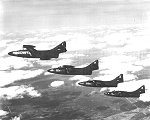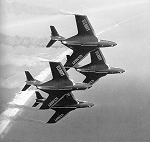|
N AVAL AVIATION NEWS |
|||||||||||
|
TWENTY YEARS WITH THE BLUE ANGELS Published in the June 1966 issue of Naval Aviation News Page 3 |
|||||||||||
|
Lt. Dave Rottgering, Public Affairs Officer, narrates the show and flies #7, the two-seat TF-9F Cougar, on orientation flights for the press. LCdr. Jack Gougar, Team Engineering Officer, is in charge of the Maintenance Crew and is responsible for 100% availability at all times. Lt. Fred Wilson is the Naval Flight Officer representative assigned to the team. He is the Special Projects Officer. One member of the team is often asked the same question, "What's it like to fly number four?" Lt. Frank Mezzadri, in his third year in the "slot" position, says, "The most difficult thing about flying number four is having to maintain station on three aircraft at the same time plus the leader's jet exhaust." The other wingmen only have to worry about one aircraft and can break away at any time. Being a member of the team is not all glamour and glory. A check of the pilots' logbooks shows that they actually flew more hours in a single year on the team than they had flown as a member of a fighter squadron in the fleet. Their official mission is to "demonstrate precision techniques of Naval Aviation to naval personnel and, as directed, to the public." The precision techniques are mostly standard fighter maneuvers developed in practice and in combat. In performing, the team demonstrates the high level of training and skill of Naval Aviators. The maneuvers demonstrated are the same basic ones taught to Navy fighter pilots now serving in Vietnam. For student pilots, the Blue Angels provide a practical demonstration of perfect airmanship. By performing at major U. S. and international shows, the team hopes to interest young men in careers in Naval Aviation and stimulate public interest in the general field of Naval Aviation. Ordinarily their tactics are executed over 30,000 feet but for demonstration purposes they are performed at low altitude. The team stresses that the performance is a demonstration - not a stunt series. Stunts require a certain amount of luck. With this almost a daily routine, they cannot afford luck. They use two basic formations during their performance. The echelon formation stacks the planes down and back from the leader at a 45-degree angle. The diamond formation places a wingman of either side of the leader with a slot plane flying directly behind and below the lead aircraft. In the diamond formation, there is a 14-foot overlap on the wings and a 36-inch separation from wing-tip to canopy. In echelon, the team executes echelon rolls, changeover rolls, and the "tuck-under-break." In the diamond, they do barrel rolls, loops, reverse Cuban Eights, a tight 360-degree turn, a slow pass at carrier landing speed with landing gear and flaps down, and the dramatic "Fleur-de-lis" which leads into their finale. Between maneuvers and while the formation is reversing course, the two solo pilots demonstrate the maximum performance characteristics of the F-11 with inverted passes, snap rolls, and high speed runs at low altitudes. The team claims to be the first in the world to fly supersonic aircraft in echelon rolls and land in a six-plane delta formation. The two solo performers were the first to fly supersonic jets in a "back-to-back" formation with the top man inverted and the second plane flying right side up underneath. A Blue Angel is a Regular Navy of Marine Corps officer between the ages of 26 and 36 with many hours of flight time. He is one of the healthiest and most able young men in the world. His selection to the team depends on many things. His flying abilities must be unquestionable. He must be able to live and work closely with his teammates for extended periods. Along with a high degree of motivation, he must be capable of withstanding long, grueling practices and road shows without downgrading performance. A Blue Angel is also an "ambassador of good will." He must be able to express himself well on radio, television, and personal appearances and give an over-all favorable impression of himself and the career he has chosen. The normal tour of duty with the team is from two to three years and the pilots usually return to a jet squadron of completion of the tour. Out of ten former team leaders, four are still on active duty. They are Captain A. R. Hawkins, Commanding Officer, USS Caloosahatchee (AO-98); Captain E. B. Holly, Commander Replacement Carrier Air Wing Twelve; Captain Z. V. Knott, Office of the Chief of Information; and Cdr. K. B. Wallace, Commanding Officer, VF-154. Qualified aviators who desire a position on the team must submit an application to the Blue Angels along with recommendations from past commanding officers. Applications are filed with the team and reviewed by appropriate authority. Those who apply are encouraged to visit with the team whenever possible to become informally acquainted with the members. At the end of this season, there will be two openings for demonstration pilots and one opening for an Officer in Charge. Selection of new members requires a unanimous decision by the team. A frequent comment after any show is, "Can you imagine being a Blue Angel? What a life!" And you know, they're right! |
|||||||||||
|
First flight leader, LCdr Butch Voris in F6F-5 Hellcat over Jacksonville in 1946. |
F8F still holds record for recips in standing start to 10,000 feet in 92 seconds. |
First jet flown by the Blue Angels was the Panther which they flew in Korean Conflict. |
Sweptwing F9F-8 Cougar was adopted by team in 1954 and flown until late 1957. |
||||||||




